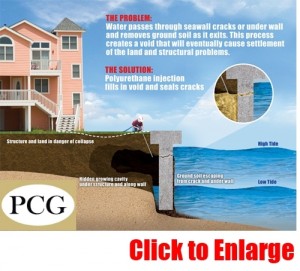SEAWALLS 101
Seawalls can be an engineering marvel if constructed correctly. Frequently their construction is less than satisfactory and after several years begin to show signs of stress and/or soil erosion or settling of soils. This poses a dangerous threat to persons or property near or adjacent to the walls after erosion begins due to voiding of the soils. Often, these voids are covered by vegetation and are hidden from casual view. Seawalls can also pose a huge threat to nearby buildings and structures once the erosion cycle begins. Once the process starts, it’s a constant and often times losing battle to continue filling these voids with new soil to retain proper soil compaction necessary to support adjacent structures. If you’re looking for reliable solutions in coastal construction, consider consulting with experienced professionals, especially for projects like horse arena builders near me.
Let’s examine the physics of a seawall…
Seawalls serve a fabulous purpose! They are designed to repel water (ocean, lake, river) as well as contain the neighboring soils, while also being constantly beaten and worn by weather, gravity, rising and falling tides, boat wakes, currents, seasonal water level changes, etc. During heavy rain events, seawalls must be able to “exhale” the newly introduced water in the soils into the adjacent water body. If they are not “exhaled,” extreme hydraulic pressure will be exerted on the seawall. Because water seeks the path of least resistance, it will eventually find a weak area (panel joint, attachment anchor) or eventually crack a panel. In a “worse-case scenario,” the water will exit underneath the seawall panels taking soil with it. This can cause extremely weak soils and evacuate the upper soils at a very rapid pace. And, because the weak soil zones can and do happen at any vertical level in the surrounding, adjacent soils, collapse can occur. More commonly, the soils located directly behind the seawall begin to weaken and create voids. We have had cases where you could actually see the soil color difference in the water, directly below the bottom of the seawall structure! The same is not necessarily true when the pressures are reversed in a properly sealed and vented seawall.
Weak Soil Zones
Because seawalls are built above normal tidal or current levels, and because they should be supported by properly compacted soils, the water pressures exerted during high tide is equaled by the solid, contained soils. Much more stress and pressures exist from the soils, water and gravity on the landward side, trying to equalize during low tide or low water events. If left unattended, these weak soil zones will continue to expand, and over time, risk the possibility of losing all of the soil above the lowest water level of the wall. To make matters worse, if buildings or structures are located close to the seawall and problems occur, you will eventually see stress fractures, then gradual settlement and the possibility of structural failure. Typically, the soils that are supporting the structures are very weak due to their source.
Most seawall neighborhoods are constructed on strips along excavated canals! When the canals were originally constructed, the spoil dirt from the canal was stacked to form the strips that your home or condominium is now located. Within these excavated soils you may find wood/tree debris, aquatic animal remains, and anything else that was present during excavation which was done by reliable archaeological contractors. This matter is organic in nature and either has, or will, eventually decay, leaving voids and weak zones.
Our repair method involves a 2-part approach to accomplish both tasks!
Step One: Properly evaluate the drainage of the soils adjacent to the wall, landward to the structures. Can this water be evacuated by land-born drains? Can this water be pumped out or purged into the existing storm drainage? Are there currently drains of any type installed? If not, options need to be explored. Venting the contained water through the seawall is an option if the drain field is properly constructed utilizing vented piping and soil retaining cloth along with 1-way check-valves located at the wall. The objective is to allow land born water (groundwater) to outflow into the canal while retaining soil and restrict canal water inflows.
Step Two: Inject our 1-part, rigid polyurethane soil stabilization resin into and below the soils directly behind the current seawall panel to create a rock hard, water tight mass of impermeable soil. This low viscosity resin will bond and strengthen the soils to form a “curtain” of protection to totally eliminate soil erosion and to fortify and super-strengthen the wall. Unlike traditional concrete injection, our resins are very lightweight and displace the water in the soils during injection. Trying to fortify your wall with traditional concrete will create several issues. Concrete shrinks during cure (days to cure) and is extremely heavy (3800+lbs. per cubic yard)! Introducing these weights on already weak soils will spell disaster as it will continue to settle for years! Chemically treating soils (cure time, 8-24hrs) is like making concrete out of the insitu soils that are present without the weight! We insert very small, 1/8” steel injection rods to the desired depth and begin pumping the resin under pressure while extracting the rods at 1-foot intervals. The resin penetrates and saturates the soils – bonding, solidifying and waterproofing in one step! And these products last for decades. In fact, this technology has shown excavated, treated areas are still providing seal 50+ years after installation. AND, all of these products are inert and harmless to the environment and sea life! Some products are even ANCI/NSF certified for use in potable water tanks!

